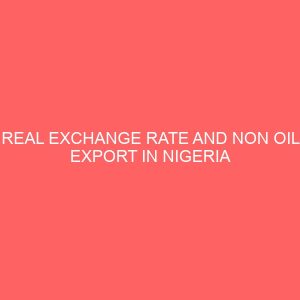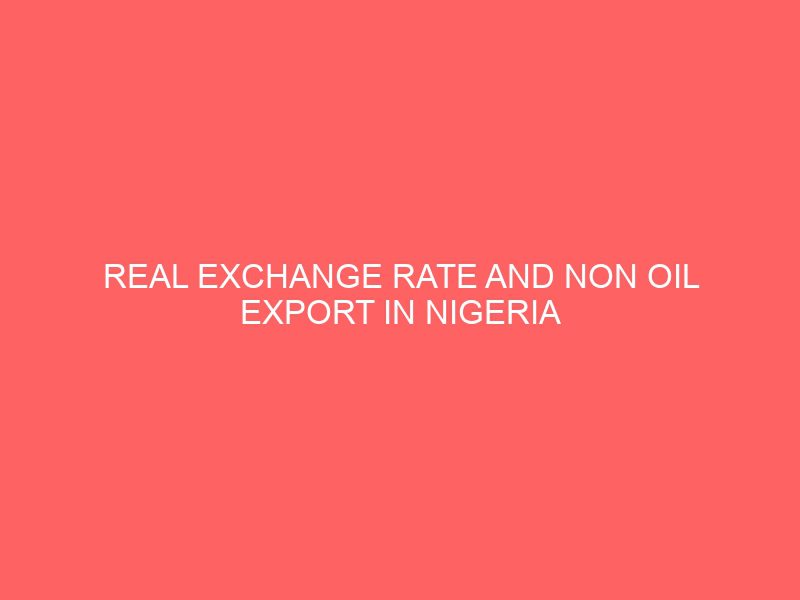Description
CHAPTER ONE
INTRODUCTION
1.1 BACKGROUND OF THE STUDY
Since exportation has a special share in the economic growth of many advanced and developing countries; as far as making those countries as the strongest countries, the effective factors; in turn, could pave way for progress of countries, particularly the developing countries. Since increase or decrease in currency exchange rate leads to the decrease or increase in export.
Nigeria is endowed with various kinds of resources needed to place her amongst the top emerging economies of the World. Unfortunately, the nation has not adequately benefited from the economic prosperity expected of a nation so richly blessed.
Nonoil exports are products, which are produced within the country in the agricultural, mining, quarrying and industrial sector that are sent outside the country to generate revenue for the growth of the economy, excluding oil products. These nonoil exports include products like coal, cotton, timber, groundnut, cocoa, beans, gum arabic etc. while real exchange rate basically, can be defined as the nominal exchange rate that takes the inflation differentials among the countries into account. Its importance stems from the fact that it can be used as an indicator of competitiveness in the foreign trade of a country. Exchange rate is used to determine an individual countrys currency value relative to the other major currencies in the index, as adjusted for the effects of inflation. All currencies within the said index are the major currencies being traded today: U.S. dollar, Euro pounds, etc. This is also the value that an individual consumer will pay for an imported good at the consumer level. This price includes tariffs and transactions costs associated with importing the good.
It is imperative to note that exchange rate, whether fixed or floating, affects macroeconomic performance such as import, export, national price level, output, interest rate etc as well as economic units such as individuals purchasing power, firms performance etc Chong and Tan, 2008. Chong and Tan 2008 empirical analysis revealed that the real exchange rate volatility is responsible for changes in macroeconomic fundamentals for the developing economies.
Export earnings assume vital importance not only for developing, but also for developed countries. Developed countries mainly export capital and final goods, while the main part of export of developing countries consists of miningindustry goods especially natural resources. According to exportled growth hypothesis increased export can perform the role of engine of economic growth because it can increase employment, create profit, trigger greater productivity and lead to rise in accumulation of reserves, allowing a country to balance their finances Emilio 2001, Goldstein and Pevehouse 2008, Gibson and Michael 1992, McCombie and Thirlwall 1994. In this context there are some challenges for countries with natural resource abundance such as oil in comparison with other countries. The main point is that in parallel with windfall of oil revenues these countries have to pay more attention to the development of the nonoil sector as well as its export performance Sorsa, 1999. Because in the most of the cases oil driven economic development leads to some undesirable consequences such as Dutch Disease in the oil rich countries. In this regard Dutch Disease concept provides certain link between the real exchange rate and nonoil export. According to this concept the appreciation of a countrys real exchange rate caused by the sharp rise in export of a booming resource sector draws capital and labour away from a countrys manufacturing and agricultural sectors, which can lead to a decline in exports of agricultural and manufactured goods and inflate the price of nontradable goods Corden 1982 and Corden and Nearly 1984.
The discovery of oil and the realization that foreign exchange could comparatively be easily derived from relegated attention to the nonoil sector to the background.
There are some motivations for conducting this research. The main motivations is that some seminal theoretical and empirical studies predict that most natural resource rich countries suffer from serious socioeconomic problems caused by their resource revenues and in this regard these natural revenues are a curse rather than a blessing for these countries Sachs and Warner, 1997; Auty, 2001; Gylfason, 2001; Gylfason and Zoega, 2002 . One of these resources causes, the so called Dutch disease, is mainly related to an appreciation of the real exchange rate, sourced from inflow of resource revenue into country, which undermines the competitiveness of the nonresource sectors manufacturing and agriculture export and therefore deteriorates this sector while it leads to higher demand for imports and services Corden and Nearly, 1982; Corden, 1984. This prediction, in particular the ultimate role of exchange rates in economic challenges of these countries, is supported by a number of empirical studies. For example, WakemanLinn et al. 2002 and sturm et al. 2009 concluded, that the exchange rate is a key economic policy issue in oil exporting countries.
Another motivation would be to examine whether or not the predictions of the international trade theory holds in an economy such as Nigeria. One of the motivations is that without conducting empirical analysis it is quite difficult or impossible to make effective policy measures for the international trade of a country. Government especially thinks that the nonoil export based development can be an engine of sustainable economic growth for the country particularly in the future postboom period; it would be useful to investigate the impact of the real exchange rate on the nonoil exports of Nigeria.
Appreciating exchange rate is one of the major factors that impede the growth of nonoil export in Nigeria. Another nonoil export that could be dwelled on is the industrial sector. It is the fastest growing sector in Nigeria economy. It comprises of mainly manufacturing and mining. But one can clearly see that since the inception of oil in Nigeria, the country has been running on a monotonic state concentrated only on oil, as its main source of revenue and for its expenditures. These have resulted to a break down in some sectors of the Nigeria economy. The agricultural sector since the emergence of oil has been partially abandoned, the farmers in the country only operate on a subsistence level, due to the fact that the policy mapped out by the government has not been really implemented and it has brought about low productivity in the economy. Efforts kicked off by the World Bank and other state and national agencies Fadama I, II amp; III policy were not able to fully revive the agricultural sector, due to the country mainly depends on oil for its survival. Looking at the industrial sector you see that you have little or no export to other countries. Nigeria has many unused resources that if really developed can create enough marketable goods in the foreign exchange market nonoil export.
The main objective of this study is to analyze the impact of changes in the real exchange rate on the export performance of the nonoil sector and to suggest policy proposals which may be useful for policymakers in nonoil export promotion issues.
1.2 STATEMENT OF PROBLEM
Nigeria remained a net exporter of agricultural products between 1960 and 1970. Goods exported include: palm oil, palm kernel, cotton, groundnut etc. Agriculture through export of nonoil products had a rosy record contribution up to 80 of gross domestic product and providing employment for over 70 of the working population. But recently there has been a steady decline in agriculture and other nonoil exports.
But the story of its decline is as pathetic, as its impact on industry that relied heavily on the sector for raw materials. Thus the declines came with surge of revenue from oil oil export.The emergence of oil has made the government, not to really plan efficiently, how to improve the real sector of the economy which produces the nonoil exports.
But the discovery of oil alone could not be held responsible completely for the misfortunes or decline in the nonoil exports. The policy instruments put in place by successive government were more of lip service than concrete action. The creation of marketing board contributed also to the decline of nonoil export since the board has the right to export the commodities. It is also pertinent to say that fixing of export product prices by marketing board, discouraged further private investment in the sector. In other sectors of the economy there was no efficient policy instrument to hold the sector and also check the activities of those sectors. Hence the emphasis on real exchange rate and nonoil export is to reengineer the economy.
1.3 OBJECTIVES OF THE STUDY
The broad objective of this study is to examine the impact of real exchange rate on the Nigerian nonoil export. The specific objectives are:
a. To evaluate Nigeria past and present nonoil export effects relative to the real exchange rate
b. To evaluate government policies or measures towards boosting nonoil sectors contribution to the economy.
c. To evaluate the factors responsible for the decline in the contribution of nonoil revenue the economy.
d. To make recommendations for improving the nonoil sector of the nation.
1.4 STATEMENT OF HYPOTHESIS
To test for the statistical significance or non significance of the data
Ho represents the null hypothesis
H1 represents the alternative hypothesis
Ho H1 there is no relationship between real exchange rate and nonoil export in Nigeria.
Ho H1 there is relationship between real exchange rate and nonoil export in Nigeria.
Results;
If Hogt;H1, then we accept the null hypothesis, that the real exchange rates has effect on the nonoil export.
If Holt;H1, then we accept the alternative hypothesis and reject the null hypothesis
that real exchange rate does not affect the nonoil export in Nigeria.
1.5 SIGNIFICANCE OF THE STUDY
The effects of the recent global economic crisis on Nigeria have reaffirmed the urgent need for economic diversification in the country. Although, no country is immune to such global crisis, the overreliance on oil export revenue by Nigeria exposes her exchange rate and economy excessively to external shocks. Therefore, there is the need to conduct a research of this nature to examine Nigeria’s exchange rate sensitivity. This study would further provide an econometric assessment of the impact of real exchange rate fluctuations on the performance of nonoil export in Nigeria. This would go a long way in helping to design policies and measures to protect these companies as well as other sectors of economy from exchange rate risk and other external shocks.
In order to understand exchange rate fluctuations better, this study would go further to identify the economic factors that are responsible for exchange rate volatility. Once we are able to identify the factors behind the fluctuations, then it would be easier for policy makers to influence the exchange rate through the price system in favor of their countries.
1.6 SCOPE AND LIMITATION OF THE STUDY
This study would also be based largely on secondary data. The reliability of the findings of this study would also depend on the liability of these data. The analysis will also be based on the nonoil sector and its effects by the real exchange rate over the years 19802010.
Also the causes and consequences of the neglect of the nonoil export shall be discussed as well. The limitation encountered in the course of this research work was manly time and difficulty in getting secondary data etc.








Reviews
There are no reviews yet.